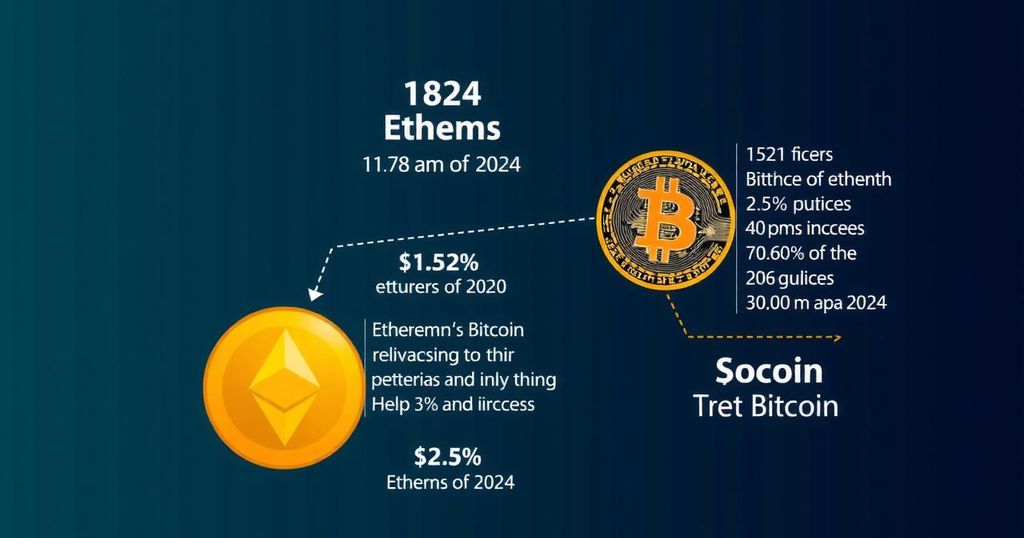Three Factors Contributing to Ethereum’s Price Lag Behind Bitcoin in 2024
Summary
In 2024, Ethereum has lagged behind Bitcoin due to a significant 34% price drop compared to Bitcoin’s 15% decline, a decrease in ETH/BTC ratio indicating reduced demand, a rise in Bitcoin market dominance to 58%, and a downturn in Ethereum’s on-chain activity metrics. These factors collectively reflect a diminished investor appetite for ETH and necessitate improvements in user engagement for potential recovery.
In 2024, Ethereum (ETH) has seen a significant underperformance when compared to Bitcoin (BTC), with ETH trading only marginally higher than its opening price at the start of the year. This stark contrast highlights three primary reasons for Ether’s lag: diminished demand relative to Bitcoin, increasing Bitcoin market dominance, and declining on-chain activity metrics associated with Ethereum. Over the past three months, the price of Ether has decreased by 34%, while Bitcoin has only experienced a 15% drop. This decline is also reflected in the ETH/BTC ratio, which has plunged about 22%, indicating a waning demand for Ether as investors shift their focus towards Bitcoin. Furthermore, cryptocurrency-based exchange-traded funds (ETFs) linked to Bitcoin have garnered notably more success since their approval by the SEC on January 10, in stark contrast to the lackluster performance of Ethereum ETFs. Reports from Glassnode emphasize that the influence of Bitcoin ETFs is substantially greater, affecting Bitcoin’s price by 8% compared to just 1% for Ethereum’s respective products. In addition to these factors, Bitcoin’s market dominance is on the rise, reaching a notable 58%—the highest it has been in 40 months as of August 5, 2024. This increasing dominance showcases Bitcoin’s strengthening position against altcoins, including Ether, further implying a general bullish sentiment towards Bitcoin among investors, leading to decreased allocations towards Ethereum. Finally, the on-chain metrics for Ethereum indicate sluggish activity. The current average of daily active addresses on the Ethereum network has dipped by 7.7% over the past month and is significantly lower than the figures recorded in 2021, suggesting a reduced level of user interaction with the network. Furthermore, the decline in unique active wallets demonstrates a lack of engagement with Ethereum’s decentralized applications (DApps), particularly in comparison to competing blockchains that have seen substantial growth in user activity. In conclusion, Ethereum’s price struggles relative to Bitcoin in 2024 can be attributed to decreasing demand as highlighted by the declining ETH/BTC ratio, an increase in Bitcoin’s market dominance indicating investor preference, and significant reductions in active on-chain engagement within the Ethereum ecosystem. For Ether to reclaim a more favorable position, it requires a revival in user transactions and DApp utilization, alongside enhanced market sentiment.
The discussion regarding Ethereum’s price performance relative to Bitcoin highlights the significant shifts in investor behavior and market metrics. Bitcoin’s position in the market has become increasingly dominant, influencing trading strategies and investment decisions in the broader cryptocurrency landscape. The performance of cryptocurrency ETFs further underscores this trend, as the relative success of Bitcoin ETFs juxtaposes Ethereum’s challenges, reflecting changing investor appetites and perceptions within the cryptocurrency investor community. Moreover, on-chain metrics serve as a barometer for platform adoption and utility, with Ethereum struggling to maintain active user engagement in a competitive landscape dominated by alternative blockchain solutions. Understanding these dynamics is crucial for appraising Ethereum’s future price trajectory.
The primary reasons behind Ethereum’s underperformance against Bitcoin in 2024 include a noticeable decline in demand for Ether, as indicated by the ETH/BTC ratio; a significant increase in Bitcoin’s market dominance, showcasing a preference for Bitcoin by investors; and a reported decrease in on-chain activity metrics, indicating reduced engagement with the Ethereum network. For Ethereum to witness price recovery, a considerable increase in transaction volumes and DApp usage is essential, along with an overall positive shift in market sentiment towards the cryptocurrency.
Original Source: cointelegraph.com








Post Comment